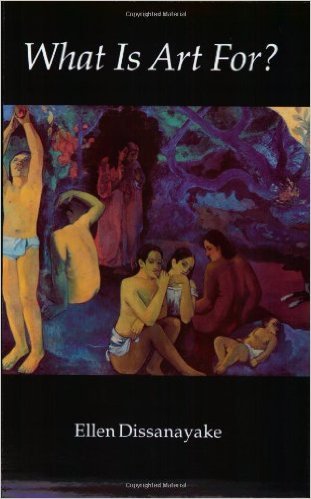I recently read What is Art For by Ellen Dissanayake. The book was originally published in 1987. It was interesting to me because it asked the question from a Darwinian perspective; how did art contribute to our evolutionary success. In her review, the author also considers the question in terms of literate and preliterate societies. It is the exploration into the impact of literacy on the human mind — albeit a short sojourn into the subject — that was both unexpected and insightful.

The author positions art as a behaviour, not just an artifact. As a behaviour it is a process resulting in some artifact (e.g., a painting) or activity (e.g., dance). The response by an individual to art — the artifact — can come in two forms: [1] an ecstatic response to the sensual properties of the work; [2] an aesthetic response to the patterns or “code” embedded in the work, the latter being a more intellectual response. The distinction between what one might consider an artistic artifact from something more mundane (e.g., a sculpture vs. a hammer) is what the author calls specialness. To make something special is to distinguish it from the every day, the routine.
By defining a behaviour and a sensory response to the behaviour the author positioned art to play a role in evolution as art can be a behaviour that when done properly enables a positive feedback to encourage continuance of the behaviour. The essential feedback loop of evolution.
The benefit of Art is said to be that it exercises our perception of reality preparing us for unfamiliar situations; it is said to be crucial for cerebral evolution, which has enabled humans to expand their consciousness and develop special skills, sharpen essential facilities and give them a firmer grasp on reality; art is said to assist our capacity to tolerate ambiguity; art is said to provide hope by making a mundane and indifferent world more tolerable. No doubt each of these would contribute in some way to the survival of the species. While the author points out that other species have survived without art, I’m sure a counter argument could be — given the context of the mass extinction we presently are experiencing — we have yet to reach the end of the story to make this conclusion.
The author continues her work by distinguishing art in the pre-literate (or primitive) world from that in the literate (modern) world. Without the written word, primitive societies depended on ceremonial rituals as a means to memorise and communicate. Art as dance, song, and physical artifact, played a role in recording, elaborating and communicating the message. The experience bound groups together with a culture, a common belief system, a shared view of reality, that strengthened them, that further tighten the bonds among them. It was the group over the individual.
The literate mind interprets reality differently than the pre-literate one. Starting simply, the idea of a word, then a sentence or proposition is the outcome of a written language. The ability to write things down allows people to ask themselves certain types of questions because facts can be isolated, recorded, looked up later, distributed easily and widely, compared, analysed, built upon to develop new insights, etc. Literacy extends beyond the word to mathematics, music and data. Books replace ritual; belief is replaced by knowledge; emotion is replaced by reason. Concepts may be regarded as distinct abstract entities capable of manipulation: ethical; moral; political statements may be deconstructed and analysed.
Trends in modern [literate] times include: [1] a migration from the reliance on social authority or group consensus to individualism and privatization; [2] change from a pre-logical mentality to a highly abstractive and self-conscious one. With emphasis on the self, at the expense of the larger family or groups, modern Western life distinguishes between having to do and wanting to do things, with a goal of trying to fashion our lives towards the latter. We have the freedom to choose our own lifestyle, something that was unthinkable until quite recent times. Yet along with this freedom to design one’s life comes isolation. The strive for inner personal well-being is at the cost of communal service. As a consequence no relationship is considered permanent; the isolated self does not look for a grand scheme by which to live, but rather for an individual route to spiritual and sensual happiness. Finally, the view of reality shifts from a common, shared world view to one held by each individual. This recognition implies that there will be a time when large numbers of people will accept that worldviews are individual and relative, that each person has a right to his own worldview, and that there are no objective standards to prove one to be better or truer than the other.
Such dramatic changes affect the role and purpose of art. Art in modern times is not a direct psychophysical reactions to rhyme, tension and release or association with powerful cultural or biological symbols, but a detached, cognitively mediated appreciation of its internal relationship. Or so says the author.
So what does this mean for art, and more specifically photography?
- Does it mean that the notion of specialness becomes more weighted from the quality of physical attributes towards the intellectual ones?
- With increased intellectualization of art, does the code become so specialised and abstract that only the few can fully appreciate the works?
- What are the different manifestation of this code and is a photograph able to capture it?
- In the past, art was designed to reflect tightly-held common world views through various stylised representations, symbols or themes. As a common world view dissipates how does art respond? How can it be understood?

Leave a Reply